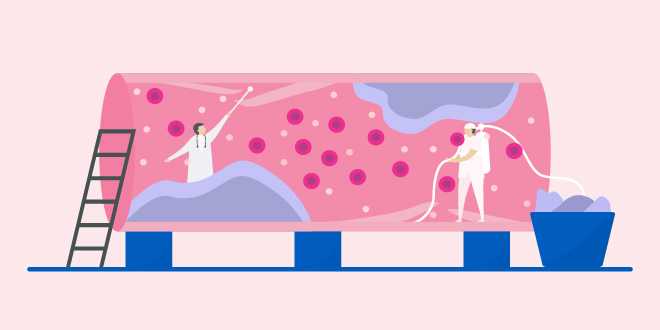Heart Health: Good vs. Bad Cholesterol

What’s the first thing that comes to mind when you hear the word “cholesterol”? For most people, cholesterol has a negative connotation.
Which is understandable. According to the World Health Organization (WHO), an estimated 39% of adult males and 40% of adult females have elevated cholesterol levels. They also estimate that high cholesterol levels account for about 4.5% of deaths annually across the globe. But that’s not the whole picture.
The reality is that cholesterol is widely misunderstood, and does not necessarily deserve its reputation. What’s more important is to understand where this mentality comes from, what cholesterol is, and understand the good and bad it does for the human body.
What is cholesterol?
Cholesterol is not some foreign substance wreaking havoc on your body, it’s found in every one of your cells. This waxy, fat-like substance is needed to make vitamin D and hormones and helps you digest your food.
That being said, your body makes all the cholesterol it needs, but it is also found in many of the foods we eat, especially animal products.
“Good” vs “bad” cholesterol
There are two different types of lipoproteins that carry cholesterol throughout the body. High-density lipoproteins (HDL) are considered “good” cholesterol, while low-density lipoproteins (LDL) are considered “bad” cholesterol.
HDL cholesterol has an important job in the body. It’s responsible for carrying cholesterol back to your liver where it can be flushed from the body. Contrary to popular belief, high levels of HDL can even lower the risk of stroke and heart disease.
High levels of LDL on the other hand can lead to plaque, which is when LDL cholesterol builds up in the walls of your blood vessels. This plaque buildup is called atherosclerosis.
People often lump in triglycerides with cholesterol. While they are both a type of lipids, triglycerides are a type of fat that helps provide the body with energy and store unused calories. Like cholesterol, high triglyceride levels can increase the risk of cardiovascular disease.
The risks of high cholesterol
Remember the plaque buildup that can come from high levels of LDL cholesterol? Over time, this plaque buildup can cause the insides of your blood vessels to become more narrow, which can restrict and block blood flow to your organs – including your heart.
Restricted blood flow to the heart can lead to serious complications including heart attacks.
Risks of high cholesterol include:
- Cardiovascular disease
- Strokes
- Heart attack
- Diabetes complications
- High blood pressure
- PAD (peripheral artery disease)
How to manage your cholesterol
While not all cholesterol is bad, high levels of bad cholesterol can be dangerous. You often don’t know or don’t have other symptoms of high cholesterol until you have a serious complication like a stroke or heart attack. That’s why it’s vital to take steps to manage your cholesterol levels.
Get checked
There are varying opinions about when to start getting your cholesterol checked, but most providers recommend starting early in life. The United States Centers for Disease Control and Prevention (CDC) states that “Cholesterol should be checked starting early in life—even children and adolescents should have their cholesterol checked.”
Most adults should have their cholesterol checked every four to six years, or more if they have heart disease, a family history of high cholesterol, or other health conditions that may be impacted by high cholesterol, like diabetes.
Dietary changes
Foods high in saturated fats like highly processed foods, dairy, and red meat may increase your cholesterol levels. Eating a diet high in fiber and healthy unsaturated fats like olive oil, fatty fish, nuts, and seeds can be helpful in managing cholesterol levels.
Stay active
Physical activity levels can play a huge role in cholesterol and overall heart health. One study found that when compared to inactive people, people who are physically active have a 21% lower risk of developing cardiovascular disease and a 36% lower risk of death from cardiovascular disease.
Getting regular exercise can be daunting or not realistic for everyone’s body or lifestyle. Every little bit counts, but experts recommend 150 minutes of moderate-intensity aerobic exercise weekly. They also recommend at least two strength training sessions a week.
Avoid tobacco products
The chemicals in cigarettes can cause damage to your heart and blood vessels and can double your risk of cardiovascular events. Smoking not only lowers your good cholesterol levels, it can also make your bad cholesterol “stickier,” making it more likely to cling to the walls of arteries and clog them.
Manage stress levels
Stress plays a huge role in not only your mental health but your physical health as well. Some stress is normal, but not being able to manage your stress, or high levels of long term stress can cause high levels of the stress hormone cortisol.
High cortisol levels have been linked to increased levels of blood cholesterol, triglycerides, and blood pressure. Stress may even cause changes in the body that increase the buildup of plaque in the arteries.
Be aware of your family history
High cholesterol can also have a genetic component. About one in 250 people have a genetic disorder called familial hypercholesterolemia (FH). This disorder causes an increased level of LDL cholesterol and can increase your risk of heart disease and the complications that come with it at a younger age.
If you have FH or if high cholesterol runs in your family, it’s especially important to follow a heart healthy lifestyle. You may also need medication, like statins, to help control cholesterol levels.
Your heart health
Cholesterol levels and heart health are not something to be taken lightly. That being said, it is something that you can actively manage by making small lifestyle changes and tweaks throughout your days.
Having a better understanding of different types of cholesterol and how they affect your body is a great first step in taking control of your heart health.








